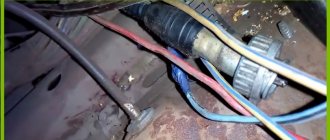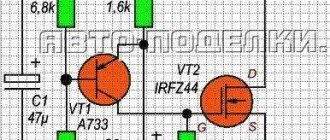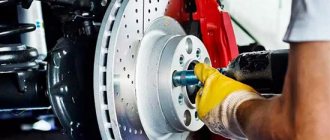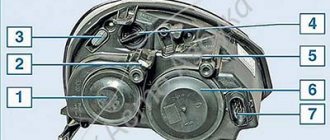Today, more and more drivers are mastering extreme driving techniques in order to learn how to control the behavior of the car in almost any unforeseen situation. One of the important skills of extreme driving is controlled skidding. A spectacular sight, but if you have no idea how to use it, the consequences can be unpredictable.
Controlled skidding is a spectacular sight
Difference between drift and drift
From a physics point of view, a skid is the application of a force to the rear axle perpendicular to the direction of the straight-line movement. It is precisely this vector of application of force in sliding that turns the car around its axis. In this case, there is always a difference in the coefficient of adhesion between the rear and front axles. In simple words, during a skid, the rear of the car tries to overtake the bow.
Demolition has a slightly different nature. A similar phenomenon is possible only at the front axle. In the event of a drift, the car does not change the vector of its movement following the turn of the steering wheel. This is due to the wheels losing traction with the road surface. During demolition, the car, even despite the wheels being fully turned, can only deviate slightly from the straight-line vector.
When to be ready
Only in rare cases can loss of control over the car be a consequence of unforeseen circumstances (for example, a tire burst while driving at high speed). In most cases, this phenomenon has specific prerequisites:
- too much speed at the entrance to the turn;
- ignoring road conditions. Most often, drivers make this mistake on the roads in winter or during leaf fall. At such times, there is a high probability that, while in a turning arc, you will end up in an area that is icy or covered with wet leaves. A sharp change in the coefficient of adhesion to the road surface will inevitably lead to sliding of one or two axles at once;
- incorrect pedaling. A sharp press on the gas in a rear-wheel drive car can provoke a skid in exactly the same way as a “blow” on the brakes when cornering in the case of a front-wheel drive car;
- incorrect steering operation. Too active, jerky movements of the steering wheel can provoke a skid or drift of the front axle. Repeated turns in different directions can cause a rhythmic skid, when each subsequent change in direction increases the centrifugal forces acting perpendicular to the straight-line movement.
Basics
Even a perfect understanding of the theoretical principles of getting out of a skid and fighting drift will not help you if you do not adhere to a few simple rules:
- comfortable fit and correct position of hands on the steering wheel. The last factor is especially important, since every fraction of a second is important in regaining control of the car;
- concentration, which is commensurate with road conditions. You should not take your eyes off the road if you are driving in conditions of poor visibility or slippery road surfaces.
Article on the topic: Runflat tires - what are they?
Features of all-wheel drive vehicles
All-wheel drive: traction distribution schemes on all wheels
The all-wheel drive vehicle flaunts clever features that attract the attention of consumers:
- has the most efficient acceleration dynamics;
- tends to overcome difficult off-road areas;
- able to easily climb ice slides.
However, not every all-wheel drive transmission is capable of efficiently implementing these characteristics. However, even the full implementation of immediate tasks does not occur in an uncompromising manner. Much depends on the layout of the all-wheel drive :
- constant;
- connected by means of automation;
- manually connected.
Permanent all-wheel drive in winter: features and difficulties
The full all-wheel drive layout ensures that power is constantly circulated between the engine and the front and rear axles. The main structural unit of the system is a transfer case , which distributes traction between two cross-axle differentials. The node includes :
- center differential;
- a locking device that provides a rigid connection between the front and rear axles (viscous coupling, friction clutch, self-locking differential);
- a chain transmission through which torque is supplied to the front axle shaft.
It is the full-fledged all-wheel drive that is an indispensable assistant in winter : power is supplied to all 4 wheels continuously both on asphalt and off-road, and the instantly activated lock allows you to confidently storm the snow-covered “intersection”.
The classic emphasis on the cross-country ability of a permanent all-wheel drive vehicle is made to the detriment of other qualities:
- large mass;
- obviously increased fuel consumption;
- the complexity of the design implementation, significantly increasing the cost of the option.
Universal technological solution: plug-in all-wheel drive
A hybrid alternative to a permanent 4x4 distribution scheme - front-wheel drive with an electronically connected rear axle on demand . The transmission layout is a complicated version of the “front-wheel drive”:
- The front axle differential is traditionally connected to the gearbox;
- primitive transfer case: bevel gear that transmits torque from the front axle to the cardan drive;
- unit connecting the rear axle: viscous coupling or friction unit.
The electronic continuously variable power distribution is tempting:
- relatively low cost of the product;
- small dimensions and weight of components;
- a slight increase in fuel consumption compared to the front-wheel drive version.
However, the solution is quite a compromise:
- on off-road and snowy areas, a blocked clutch is prone to rapid overheating and failure;
- on a normal highway, the car is practically in front-wheel drive mode (a small amount of power is transferred to the rear axle - up to 10-20%);
- full use of the rear axle is only possible when the front wheels slip or start.
It is worth noting that it is very difficult to prevent skidding with all-wheel drive of this arrangement . A sudden transmission of torque to the rear wheels, which occurs when the front axle slips, will require precious actions from the driver.
Conservative approach: manual all-wheel drive
By eliminating the differential from the full-fledged all-wheel drive system and replacing the electronic locking with the possibility of manual connection through the “transfer case” of the front axle, you can get a primitive small-sized mechanical all-wheel drive system. The design inherent to purely off-road vehicles has the following features :
- resistance to large mechanical loads;
- in the activated state, a 50/50 ratio is ensured;
- when turned on, reliable mechanics can ruin the transmission on the asphalt;
- switching occurs with the vehicle stationary.
Car with live rear axle
If a rear-wheel drive vehicle skids, the procedure is as follows:
- you need to hit the clutch and take your foot off the gas pedal. If your car has an automatic transmission, simply release the accelerator pedal. By using your feet, you help restore traction of the rear wheels with the road surface;
- at the same moment you need to start turning the steering wheel in the direction of the skid. If you are turning clockwise, the steering wheel must be turned in the opposite direction.
Why are these skills needed?
Not everyone understands why they need to undergo training and master the skills of controlled skidding.
After all, you are not going to become a participant in a car race. And the technology itself does not provide such opportunities. But training in emergency and extreme driving is worth taking. And there are several reasons for this.
Extreme and emergency driving are completely different concepts.
Even if you have an automatic transmission and you don’t know how to skid your car, that is, how to drift, it’s worth learning how to drift in a controlled manner.
Front-wheel drive
For a front-wheel drive car, the procedure is as follows:
- turn the steering wheel towards the skid;
- Do not release the gas under any circumstances; By measuring the force, you can even add traction to the wheels. The force that needs to be applied will depend on the degree of development of the skid. In the initial stage of development, even 30% of the pedal stroke will be enough. To overcome a deep skid, the pedal must be pressed to the floor.
The essence of the manipulation is to start performing it with lightning speed, to pull the car out of the skid with the drive axle.
Braking on slippery roads
How to stop a car on a slippery road if there is not much space left before the cars standing at a red traffic light?
The first thing to do is remember to use engine braking and forget that you have a left foot. If you do not touch the clutch pedal, the engine will help you brake.
It's more difficult with the right leg. Initially, you need to overcome the desire to press the brake pedal as hard as you can.
Remember, the braking distance on wheels that are blocked and sliding on the road increases by at least 2 times compared to braking on unblocked wheels!
The optimal braking option is a measured force on the brake pedal, ensuring maximum braking efficiency without the wheels blocking and sliding on the road.
However, in extreme conditions, few people manage to control the first press of the brake pedal. Typically, drivers reflexively apply the brakes as hard as possible.
We will assume that you, like many others, failed to “contain your emotions” and the first time you also “squeezed” the brakes. The car's wheels began to spin and it began to skid.
If you continue to hold the brake pedal “to the floor”, the skid will develop, and your car will acquire a stable torque. Therefore, as soon as you felt some “freedom” of your car, saw that the “nose” of your car returned back after the “peck” at the beginning of braking, and that the trunk began to deviate to the side - you must immediately release the brake pedal!
Yes, yes, here they are, the cars are standing, and you need to release the brake pedal! If this is not done, then, rotating around its axis, your car will crash into standing cars!
As soon as you overcome the instinct to “press on the brakes as hard as you can” and tame the irrepressible strength of your right leg, the rear wheels of the car will immediately stop skidding and return to the track of the front ones. The physics of phenomena in a car is such that the rear wheels always want to follow the front wheels and only unreasonable actions of the driver cause them to deviate from the given trajectory.
Therefore, as soon as the wrong action on the part of the driver stops, the skidding of the car that has begun will also stop!
Let's draw an important conclusion:
To stop a skid that has begun, you should take the opposite action to the action that led to the skid!
It could be a little shorter: Action – Skid – Reaction . This rule is suitable for solving problems of incipient skidding during braking, acceleration, and also when skidding on a bend in the road.
Now let's go back to the previous events, because we haven't stopped yet, but there are cars ahead!
You need to release the brake pedal at the beginning of a skid, of course, not forever, but only for a moment, after which you need to “press on the brake” again. Only the second time you need to press the pedal wisely, using less force and trying to feel the edge of the wheels locking.
However, as often happens in practice, the driver fails to find the edge that will ensure braking without locking the wheels a second time. The force on the brake pedal again turned out to be excessively large, the rear wheels began to skid again and the car wanted to skid. But now this shouldn’t scare us, we have a rule that we can use!
Skid?! And why? Did you press the brake pedal? Well, do the opposite - stop pressing the pedal. What? Do you need to stop? So there is a brake pedal - press on! Skid again? Why? And so on.
Depending on the condition of the road surface and the skill of the driver, it is necessary to repeat the “press and release” cycle three, five, ten times, or, better said, as many times as necessary to stop the car in a particular traffic situation.
The above-described method of combating skidding that occurs when braking on a slippery road has its own name: “Intermittent braking.”
If the route of your trip runs along a snowy or even just wet road, then you cannot do without “intermittent braking”. At the same time, you must know and remember that in two specific situations, any braking, including intermittent braking, is unacceptable!
On small slippery sections of the road, you cannot touch the brake pedal at all; only inaction can save you!
Spring, March, drops, streams and large flat puddles. Those of you who get up early in the morning may also remember the second state of these spring puddles. Smooth and durable ice will shine on them for about an hour until 9–10 am.
Unfortunately, in the spring these skating rinks can be found not only on the sidewalk, but also on the roadway. The slightest touch on the brake pedal or any other action by the car's controls instantly leads to an almost uncontrollable skid, and the car approaches the opposite edge of the ice-asphalt sideways. And then what is called overturning or, more simply, “turning over” occurs.
The conclusion is simple:
If you find yourself on a small section of a slippery road, then “without breathing,” without changing anything, drive out of it the same way you entered. In this case, passivity is salvation.
A wet roadside is the second case where lightly pressing the brake pedal can lead to serious consequences.
If, when driving at high or medium speed, a car slides with its right side onto a wet, unimproved shoulder, then a huge difference arises in the coefficient of road adhesion between the right and left wheels. Under these conditions, any braking, even very soft, usually ends with the car overturning.
You can avoid “shifting” in such a situation only if you refrain from active braking and use the steering wheel correctly! And believe me, the work ahead is not easy.
At first, the front right wheel cannot overcome the edge of the asphalt and get out of the mud. In order for the wheel to overcome the edge and get onto the asphalt, you have to turn the steering wheel more and more to the left. And then, at some point, with a sharp jump, the right wheel finally gets out from the side of the road onto the roadway.
But where did the car go? She rushed to the left oncoming side of the road! And this was the second hidden part of the problem.
If you initially know about the impending sharp change in the trajectory of movement, then, of course, you can prepare for active steering, first to the left, and then no less actively to the right. But it’s better not to “jump off while moving” onto the wet side of the road. If going to the side of the road is unavoidable, then at least you should try to reduce your speed before leaving the asphalt.
- Intermittent braking helps prevent the vehicle from skidding and shortens the braking distance.
- On small sections of slippery roads, any actions by the vehicle controls are strictly prohibited.
- If, when driving a car on asphalt, its right wheels slide onto a wet, unimproved shoulder, you should try to return to the asphalt without using active braking.
4x4
A four-wheel drive vehicle sliding is the most difficult situation presented. The problem is that all wheels are connected to the accelerator pedal at once. In this case, each wheel receives its own portion of torque from the engine. This factor depends on several parameters at once: the type of all-wheel drive, differential settings, the driver-selected control mode for the 4x4 system, the presence of intelligent stabilization systems, and others. Each SUV or crossover is individual in this regard.
It is impossible to give precise recommendations that would work in 100% of extreme situations to drivers of cars with all-wheel drive.
The only condition that remains true is the rotation of the steering wheel in the direction of the skid. But you need to be especially careful with gas. Professionals recommend pressing the accelerator pedal just enough to avoid losing traction to the wheels. It is impossible to add gas, as we would do in the case of a front-wheel drive car, or, conversely, to release it completely when driving a car with a driven rear axle.
General recommendations
It is not recommended to study purely from videos and without an instructor. Nowadays, even on a motorcycle, some actively drift.
The key to a successful skid is the absence of blocking on the wheels when rotating.
Moreover, this rule is the same for all cars. It does not depend on what type of drive is provided on the vehicle.
How to prevent dynamic skidding
The main mistake of many drivers is a delayed reaction to the behavior of the car. Even for experienced drivers, slipping is not a common situation, so they not only often get lost, but also do everything late.
Reacting to the slide and trying to catch the rear of the car, the driver turns the steering wheel in the direction of the skid. The car straightens up. This is the most crucial moment. Straightening up, the car has an inertial force, which will now provoke a skid, but in the opposite direction. In order to prevent this, you need to return the steering wheel to the “zero” position shortly before the car straightens. On a front-wheel drive car, at such moments you can even slightly release the gas to allow the wheels to grip the road.
Article on the topic: Unscrewing the oil filter without a puller
This is quite difficult to do, so even a good driver may need several techniques to do this. It is important that the amplitude of the steering wheel turn with each subsequent attempt to catch the rear of the car is less than the previous one. Only in this case will you be able to regain control of the car.
Forget about the brakes
Slamming on the brakes is something you should never do. Why? - you ask. If the car begins to skid, pressing the brakes will provoke additional unloading of the rear wheels. This will lead to an even greater loss of rear axle traction.
It is worth recognizing that for almost 90% of drivers on the roads, pressing the brake pedal is an almost instinctive movement. In order not to aggravate the situation by instinctively slamming on the brakes, at first you need to periodically remind yourself of this rule. It is best to consolidate it with practice.
How to check the engine oil level correctly
If you do not have such skills, then if a dangerous situation arises, you can end up in a serious accident. There is a risk of becoming a participant or even the culprit of an accident. The second option is even worse, since in this case the responsibility for damaged cars and injuries to people will fall entirely on your shoulders. You can imagine how much you will have to pay to repair several cars, as well as pay for the treatment of victims. As you understand, nothing good can come out of this by definition. Therefore, it is better to try to prevent such a situation.
There are 2 main situations when an uncontrolled skid can occur.
To cope with such situations, you need to show composure and remember all the skills that the driver acquired during training in theory and practice courses.
It is recommended to learn drifting techniques if you have some experience and the ability to feel the dimensions of your car.
Most often, such courses are conducted on the student’s machine. This makes it easier to get used to the behavior of the car that a person drives every day. Although introductory lessons are also conducted on driving school cars.
How does a driver end up in a skid?
As for situations with the occurrence of a (controlled) skid, there are 2 options.
One of them is quite justified for performing the maneuver. The other is more controversial.
- The driver accidentally causes a skid, after which he immediately takes control of the situation. That is, an uncontrolled skid turns into a controlled one;
- The driver deliberately provokes the rear axle to stall in order to get a thrill and an adrenaline rush from it. Not the best decision. Only if it's not a sporting event.
I’ll say right away that I don’t support the idea of a special drift. Especially when it comes to stunts in the middle of the roadway, under the windows of multi-story buildings. Only on specialized sites. Just like the police U-turn.
Demolition
Now you know how to stop a skid, but what to do when the wheels are turned out and the car continues to “slide” straight?
You will have to get rid of one more destructive instinct. Most drivers, not feeling the response from the car when turning the steering wheel, begin to twist the steering wheel to an even greater angle. You need to do the diametrically opposite - slightly reduce the steering angle. It is strictly forbidden to press the gas at this moment.
If the gas pedal was pressed at the moment the demolition began, you need to literally drop it. This way you will load the rotary axis a little. You can also press the brake pedal lightly. If the car does not have an ABS system, its operation can be simulated by intermittently pressing the pedal. It is important to prevent the wheels of the drive axle from locking.
As soon as the car starts to turn, you can turn the steering wheel a little again. In this way, you can feel the grip of the wheels with the road surface, overcome drift and prevent the car from skidding.
What is this
A skid is the movement of a vehicle, which is caused by lateral sliding of the rear axle.
Often, skidding occurs in situations where the driver turns while simultaneously pressing the accelerator pedal hard or sharply pressing the brake pedal to the floor. If such actions are performed, the rear wheels of the car immediately lose the necessary grip on the road surface. This is where sliding occurs, since the car can no longer cling to the surface.
Our verdict
All-wheel drive makes life easier, but does not guarantee complete safety. One of the problems is the driver’s inflated expectations or an incorrect assessment of road conditions or capabilities (their own and the car’s) due to more stable behavior compared to a single-wheel drive. And when this threshold is exceeded, all-wheel drive turns out to be quite specific when driving “at the limit” and more difficult for an inexperienced driver. And at a minimum, it requires studying theory and practicing basic skills in a safe environment.
Safety is not just a word. All-wheel drive vehicles in the Automotive Business ad database
Skidding during hard acceleration
Overcoming a skid that occurs during sudden acceleration is not at all difficult. But first, allow me a few lines of moral teaching.
Probably, we need to finally understand that harsh actions on a slippery road (and on a normal one too) are clearly contraindicated. If we speak in a philosophical sense, then a good driver in his thoughts and actions does not have verbs that imply harsh action on any section of the road and in any weather.
Instead of “I’ll pass” - “I’ll pass” (and if I “don’t pass”, then I’ll stop), instead of “I’ll spin” - “I’ll turn” (maybe quickly, but not sharply), “I’ll hit the gas or the brakes” - “ I’ll work the pedal” and so on. Many other verbs can be changed to others that are more acceptable for the road from the point of view of traffic safety.
As for skidding during sudden acceleration, we have a basic rule for dealing with any skidding: “Action – Skid – Reaction” .
If in winter, when the traffic light turns green, you want to be the first to leave the intersection, and you press the gas pedal as hard as you can, then it may happen that your car will be the last to leave or will not leave at all, remaining for a long time in the door or in the wing of the neighboring one. car. Do not forget that skidding occurs not only during braking, but also during any unreasonable action by the driver, which leads to the wheels slipping relative to the road surface.
If a skid occurs due to too much gas, then you need to make it less or release the gas pedal altogether, otherwise your car will continue to “float” towards the neighboring car.











